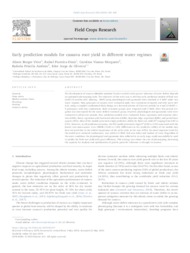Early prediction models for cassava root yield in different water regimes.
Early prediction models for cassava root yield in different water regimes.
Author(s): VITOR, A. B.; DINIZ, R. P.; MORGANTE, C. V.; ANTONIO, R. P.; OLIVEIRA, E. J. de
Summary: The development of cassava (Manihot esculenta Crantz) varieties with greater tolerance of water deficit depends on optimized phenotyping tools. The objective of this work was to develop early prediction models of final root yield (12 months after planting - MAP) using physiological and agronomic data obtained at 4 MAP under two water regimes. Nine genotypes of cassava were evaluated under two treatments (irrigated and with water deficit), using a complete randomized block design, in a factorial scheme of 2 harvest periods (at 4 and 12 MAP) × 9 genotypes, with four replications. Both treatment groups were irrigated until 3 MAP. After this period, irrigation was interrupted for the water deficit treatment group. Fourteen physiological and agronomic traits were evaluated in all harvest periods. Four prediction models were evaluated: linear regression with stepwise selection (LRSS), linear regression with backward selection (LRBS), Bayesian ridge regression (BRR), and partial least squares (PLS). Most of the models presented a high predictive ability for final root yield (R2 ranging from 0.83 to 0.91). However, in all prediction scenarios, the PLS model presented a high R2 (0.84 to 0.91) associated with the lowest root-mean-square error (RMSE) (0.82 to 1.60). Differences in the predictive ability of the models may have occurred due to the relative importance of the early traits. In the case of PLS, the most important traits for the model were stomatal conductance, root yield at 4 MAP, leaf area index and number of roots. Regardless of the water condition, the physiological and agronomic data collected at an early stage could successfully be used to predict the final root yield with great efficiency. This strategy can reduce the cost of phenotyping, increasing the capacity for analysis and optimization of genetic gains for tolerance to drought in cassava.
Publication year: 2019
Types of publication: Journal article
Unit: Embrapa Semi-arid Region
Observation
Some of Embrapa's publications are published as ePub files. To read them, use or download one of the following free software options to your computer or mobile device. Android: Google Play Books; IOS: iBooks; Windows and Linux: Calibre.
Access other publications
Access the Agricultural Research Database (BDPA) to consult Embrapa's full library collection and records.
Visit Embrapa Bookstore to purchase books and other publications sold by Embrapa.

